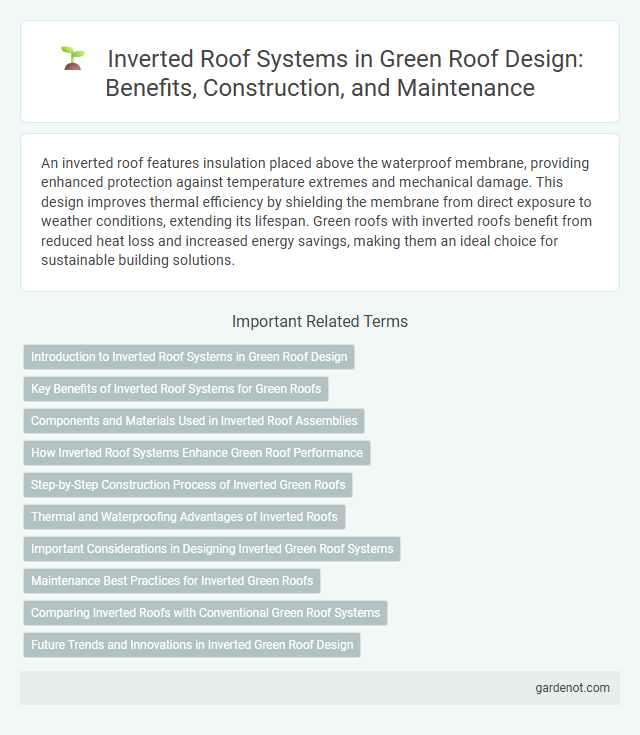An inverted roof features insulation placed above the waterproof membrane, providing enhanced protection against temperature extremes and mechanical damage. This design improves thermal efficiency by shielding the membrane from direct exposure to weather conditions, extending its lifespan. Green roofs with inverted roofs benefit from reduced heat loss and increased energy savings, making them an ideal choice for sustainable building solutions.
Introduction to Inverted Roof Systems in Green Roof Design
Inverted roof systems in green roof design feature insulation layers placed above the waterproofing membrane, protecting it from temperature extremes and mechanical damage. This configuration enhances the roof's durability and thermal performance while facilitating efficient water drainage essential for healthy plant growth. By isolating the waterproofing layer beneath insulation, inverted roofs support sustainable urban environments through extended roof lifespan and reduced energy consumption.
Key Benefits of Inverted Roof Systems for Green Roofs
Inverted roof systems provide excellent thermal insulation by placing the waterproofing layer below the insulation, protecting it from temperature extremes and mechanical damage. This configuration enhances the longevity of the waterproof membrane, reducing maintenance costs for green roofs. The added insulation stability supports healthier plant growth and improves overall energy efficiency by minimizing heat loss and gain.
Components and Materials Used in Inverted Roof Assemblies
Inverted roofs utilize a waterproof membrane placed directly on the structural deck, overlaid by insulation boards made of extruded polystyrene (XPS) for moisture resistance and thermal performance. Protective layers such as separation fleece or drainage mats are installed above the insulation to safeguard the membrane and facilitate water drainage. The assembly is completed with ballast materials like gravel or paving slabs that secure insulation and provide weight stability against wind uplift.
How Inverted Roof Systems Enhance Green Roof Performance
Inverted roof systems enhance green roof performance by placing insulation above the waterproof membrane, protecting it from temperature fluctuations and mechanical damage. This configuration improves thermal efficiency, reduces heat loss in winter, and prevents overheating in summer, contributing to greater energy savings. The additional protection extends the membrane's lifespan, ensuring long-term durability and optimal green roof functionality.
Step-by-Step Construction Process of Inverted Green Roofs
Inverted green roofs feature a waterproof membrane positioned beneath the insulation layer, protecting it from temperature fluctuations and mechanical damage. The construction process begins with installing the structural deck, followed by the waterproof membrane, rigid insulation boards placed on top, and a protection layer before the drainage and substrate layers are added for plant growth. Final steps include planting vegetation suited for green roofs, ensuring proper root barriers, and implementing irrigation systems to maintain healthy vegetation and roof longevity.
Thermal and Waterproofing Advantages of Inverted Roofs
Inverted roofs provide superior thermal insulation by placing insulation above the waterproofing layer, protecting it from extreme temperature fluctuations and mechanical damage. This configuration enhances waterproofing durability as the waterproof membrane is shielded from UV exposure and physical wear, extending its lifespan significantly. The thermal mass of the protective layer helps regulate building temperatures, reducing energy consumption for heating and cooling.
Important Considerations in Designing Inverted Green Roof Systems
Designing inverted green roof systems requires careful selection of insulation materials that can withstand prolonged moisture exposure, ensuring thermal efficiency and structural protection. Proper drainage layers are essential to prevent waterlogging and root damage, maintaining the roof's integrity and plant health. Attention to waterproofing membranes compatible with green roof substrates is critical for longevity and preventing leaks.
Maintenance Best Practices for Inverted Green Roofs
Inverted green roofs require regular inspection of the waterproof membrane beneath the insulation to prevent leaks and ensure structural integrity. Maintenance best practices include clearing debris from drainage layers and verifying that insulation boards remain properly aligned to avoid thermal bridges. Seasonal checks for plant health and irrigation systems enhance vegetation vitality and prolong the lifespan of the inverted green roof system.
Comparing Inverted Roofs with Conventional Green Roof Systems
Inverted roofs differ from conventional green roof systems by placing the waterproof membrane beneath the insulation, enhancing membrane protection and extending roof lifespan. This configuration improves thermal performance by reducing temperature fluctuations and mitigating heat loss more effectively than traditional setups. Conventional green roofs typically position insulation below the membrane, exposing it to temperature extremes and increasing maintenance requirements.
Future Trends and Innovations in Inverted Green Roof Design
Future trends in inverted green roof design emphasize advanced insulation materials like vacuum insulation panels to enhance energy efficiency and reduce thermal bridging. Innovations include integrating smart irrigation systems with sensors to optimize water usage and improve plant health under diverse climatic conditions. Research on lightweight, sustainable substrate alternatives aims to reduce structural load while promoting robust vegetation growth and biodiversity.
Inverted roof Infographic

 gardenot.com
gardenot.com